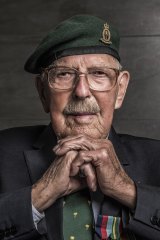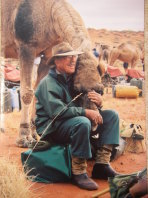Living fit and well into his 90s. How does Wilko do it?
Sun 7:25 pm +01:00, 25 Apr 2021 3John Wilkinson still remembers the grin on a Japanese pilot’s face as he roared by, a few metres above the road south of Darwin, in his Zero fighter.
Wilkinson, an artilleryman who had volunteered as a motorcycle despatch rider to relieve the boredom of guarding Darwin’s airfield, figured his young life was about to end.

Having heard the Japanese plane bearing down on him from behind, he veered off the road, ditched his motorbike and took cover beneath a pandanus palm.
But the pilot saw him and came back for a second look.

“And then he came back again and I thought, well, this is it, so I stood out on the road, thinking I would see the machine-gun bullets hitting the road in a line and perhaps I could somehow avoid them,” Wilkinson recalls.
“But he didn’t shoot. He just veered off, waved and flew away. He was wearing one of those leather caps, and I can still see the grin on his face as he went by.
“I was lucky. Very lucky.”
John Wilkinson, aged just 20, had already survived the February 1942 Japanese bombing of Darwin.
He was part of a six-man military section posted to protect Darwin’s airfield, but he and another man had only a rifle and four rounds of ammunition each. The other four men were armed with sharpened steel pickets.
“I’m not sure what we were supposed to do with the pickets,” he laughs, though he admits the first Japanese bombing raid was “rather frightening”.
He would spend much of the remainder of the war in New Guinea, transferring from the artillery to become sergeant major of what was known as a “native unit” – the 2nd New Guinea Infantry Battalion.
“I enjoyed it very much, and when the war finished we were given the job of looking after the Japanese prisoners who had surrendered,” he said.
Wilkinson survived the war without being wounded and was destined to live so long that this weekend he will march in the Anzac Day parade in Sydney.
“I’m pretty healthy,” he says. “I believe the World War II survivors will be in one group, presumably because there are not many of us left.”
He is, indeed, among a very few.
He celebrated his 100th birthday on April 2.

And he knows a bit about walking.
For close on 20 years, Wilkinson – known across the inland as Wilko – was a cameleer on expeditions through Australia’s far-flung deserts.
Aged 98, he finally had to give up those long treks alongside the camels he had grown to admire.
“I couldn’t walk fast enough,” he says.
“Wilko” lives these days in the village of Coleambally, in the NSW Riverina, where for many years he and his late wife, Joan, farmed rice.
After Joan died in 1998, Wilkinson sought out an old jackaroo friend, Rex Ellis, who had taken to running camel expeditions. After a trip through the desert of northern South Australia, “Wilko” decided camels were special creatures and he wanted to work with them.
So he became a cameleer, and when Ellis sold the operation to Andrew Harper’s Australian Desert Expeditions, “I sort of went with it as part of the equipment”.
Now that his trekking days are over, “Wilko” lives with a Jack Russell terrier known as Billy.
But he is a legend of the inland, and the Coleambally Lions Club is flying John Wilkinson and his daughter Suzie Rowe to Sydney this weekend.
So he can march and remember a life of adventure.
On his own two feet.
Wilko was still flying each year to the UK until five years ago. I asked him how he stayed so fit and healthy into his 90s. He replied that he gave up toothpaste in the 1950s and used salt to brush his teeth all his life.
Saline in fact. You might also mention his dry sense of humour, which is still to hand as he talks today aged 100.












Perhaps I’ll start using salt to clean my teeth.
I started using saline a month or 2 ago, on Tap’s advice. It works very well as a tooth cleaning agent and my gums are in the pink as well
Side benefits are that no modern chemicals are involved at all and none of my hard earned is going into the pockets of a big corporation
THE JEWISH HELL-BOMB
The atomic bomb was developed at the Los Alamos Laboratories in New Mexico. The top secret project was called the Manhattan Project, because its secret director, Bernard Baruch, lived in Manhattan, as did many of the other principals. Baruch had chosen Maj. Gen. Leslie R. Groves to head the operation. He had previously built the Pentagon, and had a good reputation among the Washington politicians, who usually came when Baruch beckoned.
The scientific director at Los Alamos was J. Robert Oppenheimer, scion of a prosperous family of clothing merchants. In Oppenheimer; the Years Of Risk, by James Kunetka, Prentice Hall, NY, 1982, Kunetka writes, p. 106, “Baruch was especially interested in Oppenheimer for the position of senior scientific adviser.” The project cost an estimated two billion dollars. No other nation in the world could have afforded to develop such a bomb. The first successful test of the atomic bomb occurred at the Trinity site, two hundred miles south of Los Alamos at 5:29:45 a.m. on July 16, 1945. Oppenheimer was beside himself at the spectacle. He shrieked, “I am become Death, the Destroyer of worlds.” Indeed, this seemed to be the ultimate goal of the Manhattan Project, to destroy the world. There had been considerable fear among the scientists that the test explosion might indeed set off a chain reaction, which would destroy the entire world. Oppenheimer’s exultation came from his realization that now his people had attained the ultimate power, through which they could implement their five-thousand-year desire to rule the entire world.
9. Although Japan had been reduced to ashes by June 1945, defendant insisted that an invasion was necessary, while ignoring peace tenders from Japan since May 1945, and defendant further claimed that the American military would suffer one million war dead while invading Japan, and that it was necessary to drop the atomic bombs on Hiroshima, August 6, 1945, and Nagasaki, August 9, 1945. In fact, as Admiral William D. Leahy pointed out in his book, I Was There, “the invasion itself was never authorized.” General Dwight D. Eisenhower, Supreme Military Commander, Admiral William D. Leahy, Air force General Curtis LeMay, and many other American military leaders, made public statements that it was not necessary to drop the atomic bombs. Political considerations dictated that it be dropped on Japan, in order to test it on a living population, and, if possible, to “tally” a million or more victims with the bombs, for the purpose of postwar intimidation of all other nations.
“But, Mr. Secretary,” said Alger Hiss, “no one can ignore the terrible power of this weapon.” “Nevertheless,” said Stettinius, “our entire postwar program depends on terrifying the world with the atomic bomb.” “To accomplish that goal,” said John Foster Dulles, “you will need a very good tally. I should say a million.” “Yes,” replied Stettinius, “we are hoping for a million tally in Japan. But if they surrender, we won’t have anything.” “Then you have to keep them in the war until the bomb is ready,” said John Foster Dulles. “That is no problem. Unconditional surrender.” “They won’t agree to that,” said Stettinius. “They are sworn to protect the Emperor.” “Exactly,” said John Foster Dulles. “Keep Japan in the war another three months, and we can use the bomb on their cities; we will end this war with the naked fear of all the peoples of the world, who will then bow to our will.”
http://www.whale.to/b/mullins8.html
http://www.whale.to/b/mullins_a.html
SURRENDER OFFER REJECTED
In March, 1945, the Japanese unconditionally surrendered.
Yes, March 1945! In that month the Japanese High Command
sent communications to the American Embassy in Moscow, to the
Russian Embassy in Tokyo and directly to the Pentagon in Washington stating that the Japanese Imperial Government wanted
to unconditionally surrender. The Americans ignored the offer.
Later, it was stated that the American authorities had difficulty interpreting the Japanese message. Amazing! They were
able to break the Japanese Blue and Purple (diplomatic and naval)
codes, but they were unable to read and understand a short message written in plain Japanese! There were many thousands of
Japanese in concentration camps in the Western United States:
why didn’t they bring the notes to someone in one of these camps
to have it interpreted?
The answer to that question is as simple as it is repugnant
to most Americans. The Japanese home islands hadn’t been
destroyed. The big show was yet to come: the B-29’s were being
lined up on Okinawa and other islands in preparation for the
International Bankers ‘urban renewal’ project on Japan.
Those old archaic cities had to be leveled. Those old factories,
railroads, port facilities, communication networks and the national
way of life had to be bulldozed into oblivion by the specially
designed demolition equipment purchased by the American taxpayer. The late Professor Carroll Quigley tells us in Tragedy and
Hope that the big planes “engaged in the systematic destruction
of all Japanese cities. The flimsy houses of these crowded urban
areas made them very vulnerable to incendiary bombs. . . On
200 DESCENT INTO SLAVERY?
March 9th, 1945, the Air Force tried a daring experiment. The
defensive armament was removed from 279 B- 29’s releasing weight
for additional incendiaries, and these planes, without guns but
carrying 1900 tons of fire bombs, were sent on a low level attack
on Tokyo. The result was the most devastating air attack in
all history. . . with the loss of only three planes. Sixteen square
miles of central Tokyo was burned out, 250,00[0] houses were destroyed, over a million persons were made homeless and 84,793
were killed. This was more destructive than the first atomic bomb
over Hiroshima five months later” (p. 815).
Two days later the B-29’s were back to do a similar demolition
job on Nagoya.
https://chinhnghia.com/Griffin-DescentIntoSlavery1980.pdf